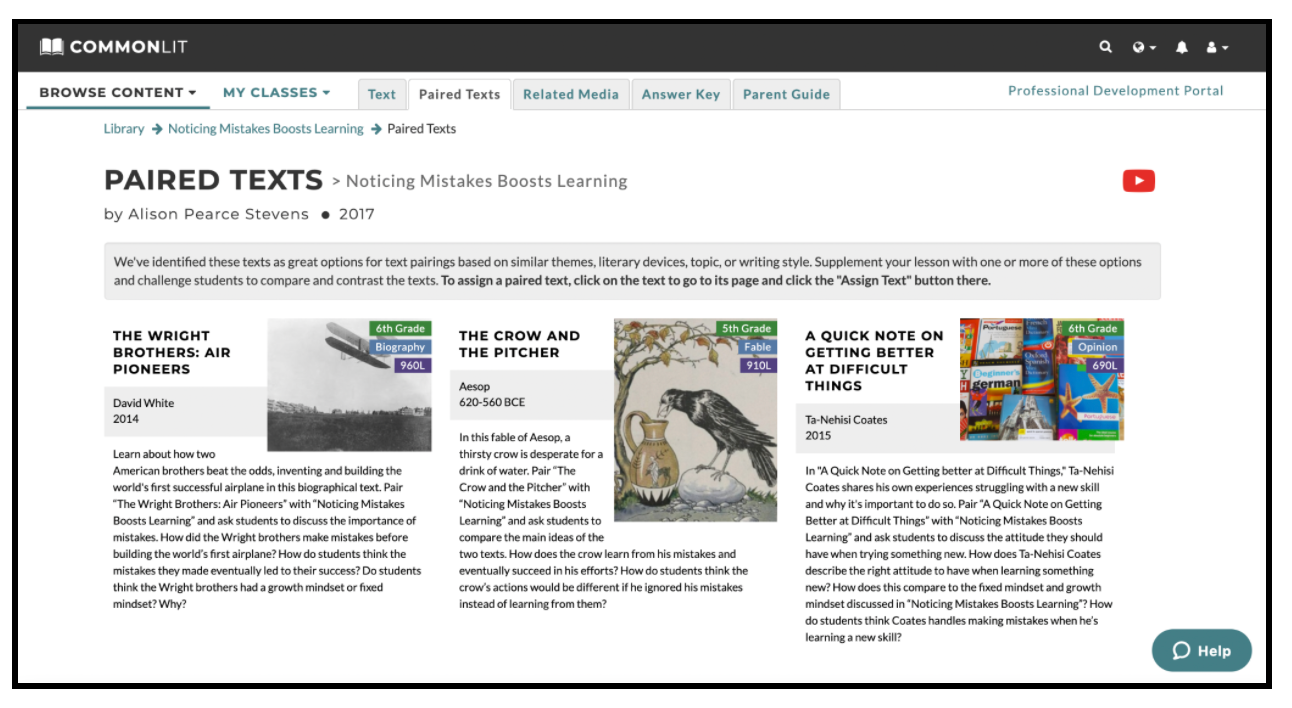Engage students in meaningful learning with these three purposeful strategies!
As teachers, we always want to make sure students are engaged in meaningful learning. It’s important to provide them with opportunities to extend their thinking and make connections while building key skills. That’s why we’re excited to share some tips to maximize student learning with CommonLit!
In this post, I’ll show you how to leverage three strategies to build engagement during your lessons. I’ll use the article “Noticing Mistakes Boosts Learning” by Alison Pearce Stevens to explain the suggestions. This great informational text describes a psychological study that found accepting mistakes helps students learn and grow.
Strategy #1: Build Background Knowledge and Extend Learning with Related Media
Every CommonLit lesson comes with Related Media, multimedia resources like videos to help you build students’ background knowledge and extend their learning. These resources come with suggested cross-textual questions you can use to incorporate student talk before or after reading the text.
For example, there are two videos under “Related Media” for “Noticing Mistakes Boosts Learning.”

To get students excited to read and provide context for the text, I might show the video “Mindsets: Fixed Versus Growth.” This video introduces students to key vocabulary so are ready to engage with the concepts in the text.
After reading, I could show the video “Small Talk | Mistakes” to extend students’ learning. In this video, students will hear from more kids about the importance of making mistakes. It’s a great opportunity for them to make text-to-text connections and discuss why making mistakes helps people learn.
Strategy #2: Synthesize Learning and Make Connections with Discussion Questions
Each lesson also comes with Discussion Questions, optional prompts you can use to help students synthesize their learning. These thought-provoking questions can help students process their ideas and make connections.
“Noticing Mistakes Boosts Learning” comes with two suggested Discussion Questions. To have students make text-to-self connections, I could use Discussion Question #1, “In the text, the author discusses how children who pay attention to their mistakes are more likely to learn from them. Describe a time when you made a mistake and what you learned from that mistake.” This question provides students with a meaningful opportunity to reflect on their own learning and growth using what they learned from the article.
To help students synthesize their learning, I might use Discussion Question 2, which asks, “In the text, the author discusses how accepting your mistakes can help you learn from them. How do you think accepting mistakes contributes to a person’s overall success?” I could also push students’ thinking further by asking them to think of examples from real life.

Strategy #3: Build Rigor and Engagement with Paired Texts
CommonLit lessons also come with Paired Texts, suggested texts from our library that you can use to build rigor and engagement. Each of these texts comes with cross-textual questions you can use to help students develop a deeper understanding of key themes and concepts.

After reading “Noticing Mistakes Boosts Learning,” I could assign “A Quick Note On Getting Better At Difficult Things,” an opinion article by Ta-Nehisi Coates. In this text, Coates shares his own experiences struggling with a new skill and why it’s important to do so.
Once students have read both texts, I can further engage them with cross-textual questions. For example, I might ask them how Coates’s perspective compares to the fixed mindset and growth mindset discussed in “Noticing Mistakes Boosts Learning.” Asking students to analyze key themes from both texts is a great opportunity to build rigor and incorporate student talk into my lesson.
Next Steps
Looking for great texts or text sets to engage your students? Browse the CommonLit Library!
If you’re interested in learning all about CommonLit’s free digital literacy program, join one of our upcoming webinars for elementary educators or for middle and high school educators!


